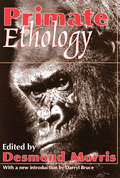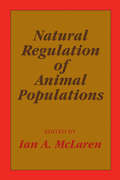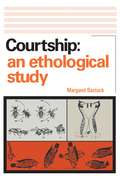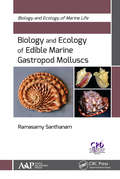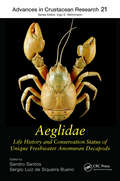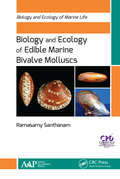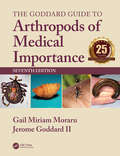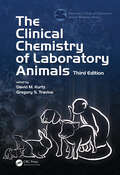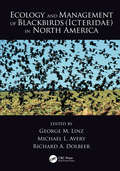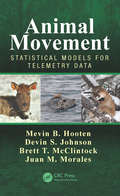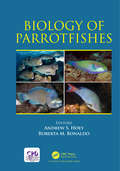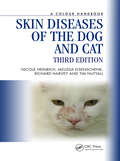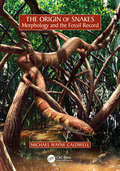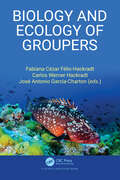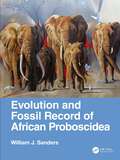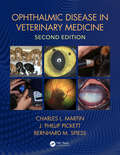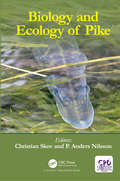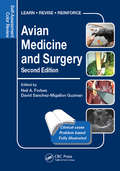- Table View
- List View
Primate Ethology
by Pendleton HerringThis is a groundbreaking workwhich brought together studiesof monkeys and apes from boththe laboratory and the field. Manybroad aspects of primate life,including facial expressions,sexual signals, grooming, play,social organization and parental care, are covered bythe contributors and provided a whole new approach toprimate behavior.
Primate Ethology
by Pendleton HerringThis is a groundbreaking workwhich brought together studiesof monkeys and apes from boththe laboratory and the field. Manybroad aspects of primate life,including facial expressions,sexual signals, grooming, play,social organization and parental care, are covered bythe contributors and provided a whole new approach toprimate behavior.
Natural Regulation of Animal Populations
by Ian A. McLarenSurveying an area dense with conflicting observations and ideas, this volume vividly depicts the current state of knowledge as well as the great diversity of opinion in the field of population ecology. Ten papers by outstanding authorities focus on three main issues-the effects of environment and population density on population dynamics, the influence of animal behavior on population growth, and the possibilities of genetic feedback or short-term evolutionary change on control of animal populations. An incisive introduction by the editor establishes a frame of reference and supplies succinct resolutions of some of the important controversies dealt with in these pages.
Natural Regulation of Animal Populations
by Ian A. McLarenSurveying an area dense with conflicting observations and ideas, this volume vividly depicts the current state of knowledge as well as the great diversity of opinion in the field of population ecology. Ten papers by outstanding authorities focus on three main issues-the effects of environment and population density on population dynamics, the influence of animal behavior on population growth, and the possibilities of genetic feedback or short-term evolutionary change on control of animal populations. An incisive introduction by the editor establishes a frame of reference and supplies succinct resolutions of some of the important controversies dealt with in these pages.
Courtship: An Ethological Study
by Margaret BastockThis concise but thorough study of courtship behavior in fish, birds, and arthropods is the first rigorous examination of the evolutionary origins and mechanisms of courtship and its contribution to biological success. Demonstrating the fruitfulness of an empirically based, inductive approach to understanding courtship, the book also explains clearly how principles of modern evolutionary theory can be successfully employed in studying behavior.The author describes many observations and experiments that have not previously appeared outside specialized journals and brings an abundance of simple yet accurate examples of animal behavior to bear on explanations of ethological concepts and evolutionary theory. No attempt is made to skim over the gaps of knowledge apparent in the study of behavior evolution; rather, the author discusses the limitations and difficulties of different approaches, critically reviews the deductions that can be and have been made from them, and tries to present enough evidence on controversial points for the reader himself to judge the validity of specific arguments.Indicating how ethological method, firmly based on biological principles, can intensively investigate and illuminate a single area of animal behavior, the book will be valuable to students and professionals in zoology, animal behavior, and experimental psychology.
Courtship: An Ethological Study
by Margaret BastockThis concise but thorough study of courtship behavior in fish, birds, and arthropods is the first rigorous examination of the evolutionary origins and mechanisms of courtship and its contribution to biological success. Demonstrating the fruitfulness of an empirically based, inductive approach to understanding courtship, the book also explains clearly how principles of modern evolutionary theory can be successfully employed in studying behavior.The author describes many observations and experiments that have not previously appeared outside specialized journals and brings an abundance of simple yet accurate examples of animal behavior to bear on explanations of ethological concepts and evolutionary theory. No attempt is made to skim over the gaps of knowledge apparent in the study of behavior evolution; rather, the author discusses the limitations and difficulties of different approaches, critically reviews the deductions that can be and have been made from them, and tries to present enough evidence on controversial points for the reader himself to judge the validity of specific arguments.Indicating how ethological method, firmly based on biological principles, can intensively investigate and illuminate a single area of animal behavior, the book will be valuable to students and professionals in zoology, animal behavior, and experimental psychology.
Biology and Ecology of Edible Marine Gastropod Molluscs (Biology and Ecology of Marine Life)
by Ramasamy SanthanamThis comprehensive volume focuses exclusively on sea snails (or gastropods), which are popular food items and occupy an important role in the commercial shell craft industry. Familiar examples include conchs (highly sought after due to their mild flavor) and escargot, abalone, and periwinkle snails. This book covers the profile (habitat, distribution, morphology, food and feeding, reproduction, conservation status, etc.) of about 180 species of commercial edible marine gastropod molluscs as well as their nutritional values, commercial importance, and pharmaceutical value. Also included is information on their prevalent diseases and parasites. The informative descriptions are presented in an easy-to-read style with neat illustrations.
Biology and Ecology of Edible Marine Gastropod Molluscs (Biology and Ecology of Marine Life)
by Ramasamy SanthanamThis comprehensive volume focuses exclusively on sea snails (or gastropods), which are popular food items and occupy an important role in the commercial shell craft industry. Familiar examples include conchs (highly sought after due to their mild flavor) and escargot, abalone, and periwinkle snails. This book covers the profile (habitat, distribution, morphology, food and feeding, reproduction, conservation status, etc.) of about 180 species of commercial edible marine gastropod molluscs as well as their nutritional values, commercial importance, and pharmaceutical value. Also included is information on their prevalent diseases and parasites. The informative descriptions are presented in an easy-to-read style with neat illustrations.
Aeglidae: Life History and Conservation Status of Unique Freshwater Anomuran Decapods (Advances in Crustacean Research #19)
by Sandro Santos Sergio Luiz de Siqueria BuenoAeglidae focuses on these unique crustaceans who are endemic to South America. The book is the first to summarize the diverse aspects of the Aeglidae, whose taxonomic features and phylogenetic relationships, evolutionary history and biogeographical background, biological characteristics, and current conservation awareness make them stand out among all other decapods. Addresses the morphology, taxonomy, and phylogenetics that characterize the Aegla and their relationship to other decapod taxa Provides in-depth treatment of the evolutionary history, biogeography, reproduction, developmental biology, and the life cycle of the Aeglidae Discusses their physiology, ecology and behavior, including physiological mechanisms associated with freshwater adaptation, population dynamics, trophic ecology, agonistic and non-agonistic behavior Covers the current conservation status of all known species of aeglids, major threats to them, the use of aeglids as flagships or umbrella species, and conservation action planning Edited by internationally distinguished leaders in this field. This will be an important reference not only for carcinologists working with this family of decapods, but also readers interested in the evolution, biogeography, taxonomy, phylogenetics, physiology, and reproductive ecology.
Aeglidae: Life History and Conservation Status of Unique Freshwater Anomuran Decapods (Advances in Crustacean Research #19)
by Sandro Santos Sergio Luiz De Siqueira BuenoAeglidae focuses on these unique crustaceans who are endemic to South America. The book is the first to summarize the diverse aspects of the Aeglidae, whose taxonomic features and phylogenetic relationships, evolutionary history and biogeographical background, biological characteristics, and current conservation awareness make them stand out among all other decapods. Addresses the morphology, taxonomy, and phylogenetics that characterize the Aegla and their relationship to other decapod taxa Provides in-depth treatment of the evolutionary history, biogeography, reproduction, developmental biology, and the life cycle of the Aeglidae Discusses their physiology, ecology and behavior, including physiological mechanisms associated with freshwater adaptation, population dynamics, trophic ecology, agonistic and non-agonistic behavior Covers the current conservation status of all known species of aeglids, major threats to them, the use of aeglids as flagships or umbrella species, and conservation action planning Edited by internationally distinguished leaders in this field. This will be an important reference not only for carcinologists working with this family of decapods, but also readers interested in the evolution, biogeography, taxonomy, phylogenetics, physiology, and reproductive ecology.
Biology and Ecology of Edible Marine Bivalve Molluscs (Biology and Ecology of Marine Life)
by Ramasamy SanthanamThis comprehensive volume provides a plethora of first-hand information on the diversity, biology, and ecology of edible marine bivalve molluscs. It covers the biology of edible marine bivalves; profiles about 180 species, providing information on their habitat, distribution, morphology, food and feeding, reproduction, conservation status, etc.; discusses their nutritional values; examines their pharmaceutical value; and looks at their diseases and parasites. This abundance of knowledge is presented in an easy-to-read style with informative illustrations. Marine bivalve molluscs play important roles in the marine ecosystems by filtering water and serving as habitat and prey for a variety of sea life. This diverse group of species, estimated at around 9,200, inhabits virtually the entire world’s oceans, from the balmy tropics to the sub-zero Arctic, and from deep oceans to sandy and rocky shorelines. Among the marine bivalves, a total of 180 species (including mussels, oysters, scallops, cockles, and clams) have long been a part of the diet of coastal human populations. Many species of marine bivalves are also commercially important for other purposes, such as pearls and shells for jewelry and decoration. The volume, part of the Biology and Ecology of Marine Life book series, will be of great use to students and researchers in fisheries science, marine biology, aquatic biology, and zoology.
Biology and Ecology of Edible Marine Bivalve Molluscs (Biology and Ecology of Marine Life)
by Ramasamy SanthanamThis comprehensive volume provides a plethora of first-hand information on the diversity, biology, and ecology of edible marine bivalve molluscs. It covers the biology of edible marine bivalves; profiles about 180 species, providing information on their habitat, distribution, morphology, food and feeding, reproduction, conservation status, etc.; discusses their nutritional values; examines their pharmaceutical value; and looks at their diseases and parasites. This abundance of knowledge is presented in an easy-to-read style with informative illustrations. Marine bivalve molluscs play important roles in the marine ecosystems by filtering water and serving as habitat and prey for a variety of sea life. This diverse group of species, estimated at around 9,200, inhabits virtually the entire world’s oceans, from the balmy tropics to the sub-zero Arctic, and from deep oceans to sandy and rocky shorelines. Among the marine bivalves, a total of 180 species (including mussels, oysters, scallops, cockles, and clams) have long been a part of the diet of coastal human populations. Many species of marine bivalves are also commercially important for other purposes, such as pearls and shells for jewelry and decoration. The volume, part of the Biology and Ecology of Marine Life book series, will be of great use to students and researchers in fisheries science, marine biology, aquatic biology, and zoology.
The Goddard Guide to Arthropods of Medical Importance
by Gail Miriam Moraru Jerome Goddard IICovering all major arthropods of medical importance worldwide, this award-winning resource has established itself as a standard reference for almost 25 years. With the globilization of commerce and the world becoming more intimately connected through the everyday ease of travel, unknown arthropod species are being increasingly encountered. This means access to up-to-date, authoritative information in medical entomology has never been more important. Now in its seventh edition, this book maintains its well-acclaimed status as the ultimate easy-to-use guide to identify disease-carrying arthropods, the common signs and symptoms of vector-borne diseases, and the current recommended procedures for treatment. Includes an in-depth chapter with diagnostic aids to help physicians to recognize and accurately diagnose arthropod-related diseases and conditions more easilyUpdates all chapters with the latest medical and scientific findings, including Zika virus, red meat allergy, new viruses found in ticks, and vaccine development for malaria and dengue feverPresents a greater medical parasitology emphasis throughout Offers electronic downloads containing additional photographs of arthropod-caused diseases and lesions, as well as instructional videos with pest identification aids, basic entomology, and insect and pest ecology.Illustrated throughout with detailed color images to aid identification, The Goddard Guide to Arthropods of Medical Importance, Seventh Edition will remain an essential guide for physicians, public health officials, and pest control professionals.
The Goddard Guide to Arthropods of Medical Importance
by Gail Miriam Moraru Jerome Goddard IICovering all major arthropods of medical importance worldwide, this award-winning resource has established itself as a standard reference for almost 25 years. With the globilization of commerce and the world becoming more intimately connected through the everyday ease of travel, unknown arthropod species are being increasingly encountered. This means access to up-to-date, authoritative information in medical entomology has never been more important. Now in its seventh edition, this book maintains its well-acclaimed status as the ultimate easy-to-use guide to identify disease-carrying arthropods, the common signs and symptoms of vector-borne diseases, and the current recommended procedures for treatment. Includes an in-depth chapter with diagnostic aids to help physicians to recognize and accurately diagnose arthropod-related diseases and conditions more easilyUpdates all chapters with the latest medical and scientific findings, including Zika virus, red meat allergy, new viruses found in ticks, and vaccine development for malaria and dengue feverPresents a greater medical parasitology emphasis throughout Offers electronic downloads containing additional photographs of arthropod-caused diseases and lesions, as well as instructional videos with pest identification aids, basic entomology, and insect and pest ecology.Illustrated throughout with detailed color images to aid identification, The Goddard Guide to Arthropods of Medical Importance, Seventh Edition will remain an essential guide for physicians, public health officials, and pest control professionals.
The Clinical Chemistry of Laboratory Animals
by David M. Kurtz Gregory S. TravlosKey features: Serves as the detailed, authoritative source of the clinical chemistry of the most commonly used laboratory animals Includes detailed chapters dedicated to descriptions of clinical chemistry-related topics specific to each laboratory species as well as organ/class-specific chapters Presents information regarding evaluation and interpretation of a variety of individual clinical chemistry end points Concludes with detailed chapters dedicated to descriptions of statistical analyses and biomarker development of clinical chemistry-related topics Provides extensive reference lists at the end of each chapter to facilitate further study Extensively updated and expanded since the publication of Walter F. Loeb and Fred W. Quimby’s second edition in 1999, the new The Clinical Chemistry of Laboratory Animals, Third Edition continues as the most comprehensive reference on in vivo animal studies. By organizing the book into species- and organ/class-specific chapters, this book provides information to enable a conceptual understanding of clinical chemistry across laboratory species as well as information on evaluation and interpretation of clinical chemistry data relevant to specific organ systems. Now sponsored by the American College of Laboratory Animal Medicine (ACLAM), this well-respected resource includes chapters on multiple laboratory species and provides pertinent information on their unique physiological characteristics, methods for sample collection, and preanalytical sources of variation for the particular species. Basic methodology for common procedures for each species is also discussed. New Chapters in the Third Edition Include: The Laboratory Zebrafish and Other Fishes Evaluation of Cardiovascular and Pulmonary Function and Injury Evaluation of Skeletal Muscle Function and Injury Evaluation of Bone Function and Injury Vitamins Development of Biomarkers Statistical Methods The Clinical Chemistry of Laboratory Animals, Third Edition is intended as a reference for use by veterinary students, clinical veterinarians, verterinary toxicologists, veterinary clinical pathologists, and laboratory animal veterinarians to aid in study design, collection of samples, and interpretation of clinical chemistry data for laboratory species.
Ecology and Management of Blackbirds (Icteridae) in North America
by George M. Linz Michael L. Avery Richard A. DolbeerShortlisted for the 2018 TWS Wildlife Publication Awards in the edited book category The various species of new world blackbirds, often intermingled in large foraging flocks and nighttime roosts, collectively number in the hundreds of millions and are a dominant component of the natural and agricultural avifauna in North America today. Because of their abundance, conspicuous flocking behavior, and feeding habits, these species have often been in conflict with human endeavors. The pioneering publications on blackbirds were by F. E. L. Beal in 1900 and A. A. Allen in 1914. These seminal treatises laid the foundation for more than 1,000 descriptive and experimental studies on the life histories of blackbirds as well as their ecology and management in relation to agricultural damage and other conflicts such as caused by large winter roosting congregations. The wealth of information generated in over a century of research is found in disparate outlets that include government reports, conference proceedings, peer-reviewed journals, monographs, and books. For the first time, Ecology and Management of Blackbirds (Icteridae) in North America summarizes and synthesizes this vast body of information on the biology and life histories of blackbirds and their conflicts with humans into a single volume for researchers, wildlife managers, agriculturists, disease biologists, ornithologists, policy makers, and the public. The book reviews the life histories of red-winged blackbirds, yellow-headed blackbirds, common grackles, and brown-headed cowbirds. It provides in-depth coverage of the functional roles of blackbirds in natural and agricultural ecosystems. In doing so, this authoritative reference promotes the development of improved science-based, integrated management strategies to address conflicts when resolutions are needed.
Animal Movement: Statistical Models for Telemetry Data
by Mevin B. Hooten Devin S. Johnson Brett T. McClintock Juan M. MoralesThe study of animal movement has always been a key element in ecological science, because it is inherently linked to critical processes that scale from individuals to populations and communities to ecosystems. Rapid improvements in biotelemetry data collection and processing technology have given rise to a variety of statistical methods for characterizing animal movement. The book serves as a comprehensive reference for the types of statistical models used to study individual-based animal movement. Animal Movement is an essential reference for wildlife biologists, quantitative ecologists, and statisticians who seek a deeper understanding of modern animal movement models. A wide variety of modeling approaches are reconciled in the book using a consistent notation. Models are organized into groups based on how they treat the underlying spatio-temporal process of movement. Connections among approaches are highlighted to allow the reader to form a broader view of animal movement analysis and its associations with traditional spatial and temporal statistical modeling. After an initial overview examining the role that animal movement plays in ecology, a primer on spatial and temporal statistics provides a solid foundation for the remainder of the book. Each subsequent chapter outlines a fundamental type of statistical model utilized in the contemporary analysis of telemetry data for animal movement inference. Descriptions begin with basic traditional forms and sequentially build up to general classes of models in each category. Important background and technical details for each class of model are provided, including spatial point process models, discrete-time dynamic models, and continuous-time stochastic process models. The book also covers the essential elements for how to accommodate multiple sources of uncertainty, such as location error and latent behavior states. In addition to thorough descriptions of animal movement models, differences and connections are also emphasized to provide a broader perspective of approaches.
Biology of Parrotfishes
by Andrew S. Hoey Roberta M. BonaldoParrotfish are found on almost every coral reef in the world. This ubiquity and uniqueness of their feeding action make them one of the most important groups of fishes within coral reef ecosystems. But why, exactly, are parrotfish so important to reefs? Can the evolution of a particular jaw morphology and feeding action really have had such a large impact on the health and functioning of the world's coral reefs? This book introduces the reader to this fascinating group of fishes (Labridae, Scarinae), from the morphological innovation of a jaw that has the power to bite through solid calcium carbonate, to the threats currently faced by parrotfish populations around the world. It contains new insights into their diet and food processing ability, and lifehistories, and concludes with an overview of emerging and future research directions.
Skin Diseases of the Dog and Cat, Third Edition (Veterinary Color Handbook Series)
by Tim Nuttall Richard G. Harvey Nicole A. Heinrich Melissa EisenschenkKey features: • Completely updated in response to developments in veterinary dermatology over the last decade • Superb and generously sized colour photographs and diagrams • Describes lesion identification and diagnostic techniques in great detail, especially useful for revision • Chapters are organized based on symptoms, and each chapter has a decision tree: gives basic and practical guidance. • Clear user-friendly design with one condition per page (or spread of pages) • Referenced thoughout to give the clinician access to the literature A Colour Handbook of Skin Diseases of the Dog and Cat was one of the first books to bring key information about skin diseases to clinicians in an easy-to-use problem-oriented format. This fully revised and updated Third Edition responds to the huge growth in knowledge about skin conditions over the last decade, including the discovery of new conditions, the development of new approaches to management, and effective new treatment options. 13 chapters covering over 120 skin, claw and ear conditions classified by their principle presenting sign. Concise, systematically structured text covering definition, aetiology and pathogenesis, clinical features, differential diagnoses, diagnostic tests and management. Flow charts in each chapter to help clinicians get to the right diagnosis. Special focus on diseases affecting paediatric patients as well as chapters discussing paw, ear and nasal planum diseases. Explanation of new treatments for atopic dermatitis. Over 350 superb colour photographs and diagrams, mostly new for this this edition. A focus on clinical practice and the need to explain the disease to the owner. Up-to-date and fully referenced throughout. This practical book continues to provide an entirely comprehensive guide to the diagnosis and management of veterinary skin conditions, in a format that is easily accessible for busy clinicians.
The Origin of Snakes: Morphology and the Fossil Record
by Michael Wayne CaldwellThis book presents perspectives on the past and present state of the understanding of snake origins. It reviews and critiques data and ideas from paleontology and neontology (herpetology), as well as ideas from morphological and molecular phylogenetics. The author reviews the anatomy and morphology of extant snakes. Methods are also critiqued, including those empirical and theoretical methods employed to hypothesize ancestral ecologies for snakes. The modern debate on squamate phylogeny and snake ingroup phylogeny using molecules and morphology is examined critically to provide insights on origins and evolution. Key Features Important major evolutionary transformation in vertebrate evolution Continuing historical debate in vertebrate paleontology Of wide interest to a core audience of paleontologists, herpetologists, and morphologists Author acknowledged as prominent contributor to debate over snake origins Based on remarkable well preserved fossil specimens
Biology and Ecology of Groupers
by Fabiana Cézar Félix-HackradtGroupers are fascinating charismatic fishes commonly found in reef habitats around the world that sustain a global multimillionaire fishery. They are an important top predator species and therefore of paramount ecological importance for reef systems' resilience. The book, Biology and Ecology of Groupers is an up-to-date review of the main bio-ecological topics involving worldwide groupers species oriented to the academic community and managers. It covers aspects of classification and phylogenetic relationships, geographical distribution, and life history related characteristics (Section I), including the major threats of groupers populations, case studies of successful management and comments about the future of groupers in our changing world (Section II).
Evolution and Fossil Record of African Proboscidea
by William J. SandersThis book details the long, diverse, and complex phylogenetic history of elephants and their fossil relatives (the Proboscidea), whose origin is deeply embedded some 60 million years ago in Africa. Most of the major evolutionary events of proboscideans occurred in Africa, and these are examined in their geological, paleoecological, geographic, and faunal contexts. Updated information about feeding adaptations, taxonomy and systematics, genetics, and site occurrences is included and summarized in tables, figures, and charts. This is the first comprehensive review of African proboscideans and illustrates the need to more actively protect elephants and ensure their survival in modern ecosystems. Key Features: Provides a comprehensive systematic review of the African proboscidean fossil record Includes a summary of taxonomy, geochronology, biogeography and morphology Documents major faunal events including those associated with hominin origins Synthesizes new data from genomic, isotopic, and microware analyses Emphasizes the role of elephants in ecosystems and the importance of conservation
Ophthalmic Disease in Veterinary Medicine
by Charles L. Martin J. Phillip Pickett Bernhard M. SpiessFeaturing a new author team, this seminal book has been completely updated and significantly expanded. Following an outline of the basic elements of ophthalmic science relevant to study and practice, the authors provide a detailed description and discussion of each condition including etiology, clinical signs, diagnosis, prognosis, and therapy, as well as a section dedicated to presumed inherited eye disorders. The focus throughout remains on the clinical needs of the practitioner and the student. Beautifully illustrated in full color, the book is aimed at trainee and practicing veterinarians interested in all types of ophthalmic diseases and disorders. Although the focus is on small animals, there is additional material on the horse and the cow. For this edition, a diverse group of authors from many geographic regions of training and practice offer a breadth of clinical expertise.
Biology and Ecology of Pike
by Christian Skov P. Anders NilssonThis book sets out to bridge the order scales among pike researchers, populations, communities, management, and fisheries. It emphasizes the progress of pike research during the last two decades, during which the order-bridging approach emerged. This framework underpins the text and the message, to convey its importance to pike research and to fish research in general. In addition, a considerable part of the book is devoted to management implications and highlights aspects of human dimensions in recreational fisheries.
Avian Medicine and Surgery: Self-Assessment Color Review, Second Edition (Veterinary Self-Assessment Color Review Series)
by Neil A. Forbes David Sanchez-Migallon GuzmanThis completely revamped second edition of Avian Medicine and Surgery includes over 260 all-new colour illustrated cases, with questions and answers fully exploring a breadth of diseases and disorders. Avian patients are a routine part of the veterinary case load and are being seen by many clinicians across the world. This book provides a unique quick reference for clinicians and a useful self-test for students by offering comprehensive, clinically-oriented information that can be quickly accessed, easily understood and applied. With contributions from leading international authorities with diverse fields of expertise, the book covers a wide range of disciplines, organ systems and species. The cases are presented in a random order, just as they would appear in daily practice, challenging the reader to address real clinical situation and offering, where possible, a comprehensive solution.
